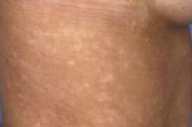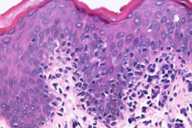Pityriasis lichenoides chronica
Published Web Location
https://doi.org/10.5070/D36n761359Main Content
Pityriasis lichenoides chronica
Jeffrey S Henning DO
Dermatology Online Journal 10 (3): 8
From the Ronald O. Perelman Department of Dermatology, New York University
Abstract
A 19-year-old woman presented with a five-year history of guttate macules and yellow to skin-colored papules with collarette of fine scale on the trunk and the upper and lower extremities. Guttate pityriasis lichenoides chronica is an uncommon presentation of this T-cell-mediated disease. It is of unknown etiology; however, an infectious agent has been suspected. It is considered in a spectrum with pityriasis lichenoides et varioloformis acuta and rarely mycosis fungoides and CD30 lymphomas. Improvement has been shown after treatment with oral tetracyclines, ultraviolet B and UVA1 phototherapy, and PUVA photochemotherapy.
Clinical synopsis
History.—In August 2003, a 19 year-old woman presented to the Bellevue Hospital Center Dermatology Clinic with a 5-year history of hypopigmented macules on the trunk, legs, and arms. This condition started on her trunk, progressed over several months, and covered her trunk, legs, and arms. New lesions appeared every few weeks. A diagnosis of tinea versicolor was made in the past, and she was treated with a variety of antifungal regiments, which included oral terbinafine and itraconazole and multiple topical regiments. She denied constitutional symptoms.
Physical Examination.— 3-mm, hypopigmented, guttate macules covered the trunk and arms. There were a few macules on the face, and there were no scalp lesions. The nails and oral mucosae were normal. There were a few skin-colored to yellow papules with a collarette of scale on the left upper arm and right flank.

|

|
| Figure 1 | Figure 2 |
|---|
Laboratory Data.— A complete blood count, basic metabolic profile, liver function tests, erythrocyte sedimentation rate, and urinalysis were normal. A rapid plasma reagin test was negative. Potassium hydroxide examinations of several lesions were negative for fungal elements.
Histopathology.— There is a sparse, superficial, perivascular, lymphocytic infiltrate with focal vacuolar interface changes and rare necrotic keratinocytes at the dermoepidermal junction. Scattered dermal macrophages containing pigment are also present.
Diagnosis.—Pityriasis lichenoides chronica.
Comment
Pityriasis lichenoides chronica (PLC), which is a benign eruption with lymphocytic infiltrates of the skin, presents as a persistent, erythematous, papular eruption with scale. Patients may have guttate, hypopigmented macules with scale in addition to papules. It is related histologically to pityriasis lichenoides et varioliformis acuta (PLEVA), which presents as a recurrent papulonecrotic eruption. Both PLEVA and PLC are diseases that share overlapping clinicopathologic features which suggest that they exist as a spectrum [1].
PLC shares immunohistologic characteristics with PLEVA. [2] PLC is a benign condition; however, because of a clonal T-cell population, some investigators feel it may be related to cutaneous T-cell lymphomas. [2] Although several studies have not found an association between malignant conditions and PLC or PLEVA, there are case reports of PLC evolving into mycosis fungoides. [2]
PLC is thought by some investigators to represent a hypersensitivity reaction to an infectious agent [2,4] since there are reports of clustering of cases and familial outbreaks and Epstein-Barr virus (EBV) serology. [4-6] PLC in association with human immunodeficiency virus infection has been reported and improves with rise in CD4 count. [7] EBV has been associated with PLEVA outbreaks, and PLC was associated with a fulminant case of infectious mononucleosis, which resolved with resolution of the EBV and treatment with narrow-band ultraviolet B phototherapy. [8] Toxoplasma was reported in PLC in 1972 in six of eleven patients. Other infectious agents that have been implicated as causing PLC include adenovirus and parvovirus B19. [8]
Currently there is no standard of treatment for PLC or PLEVA. Broad- and narrow-band ultraviolet B phototherapy, PUVA photochemotherapy, and methotrexate offer the most consistent therapeutic responses. UVA1 phototherapy has been used in Europe for the treatment of PLEVA and PLC. [3] Tetracycline was effective in some patients, and slow tapering once resolution has been achieved has been shown to prevent recurrence. [7] Cyclosporine and retinoids could be considered as an alternative therapy for cases because they have been demonstrated to be successful therapy in psoriasis. [7,8]
References
1. Shieh S. Differentiation and clonality of lesional lymphocytes in pityriasis lichenoides chronica. Arch Dermatol 2001;137:305.2. Tomasini D. Cytotoxic mycosis fungoides evolving from pityriasis lichenoides chronica in a seventeen-year-old girl: report of a case. Dermatology 2002; 205:176.
3. Klein PA, et al. Infectious causes of pityriasis lichenoides: a case of fulminant infectious mononucleosis. J Am Acad Dermatol 2003; 49:S151.
4. Dupont M. Pityriasis lichenoides in a family. Br J Dermatol 1995; 133:329.
5. Rogers M. Pityriasis lichenoides and lymphomatoid papulosis. Semin Dermatol 1992; 11:73.
6. Zlatkov NB, Andreev VC. Toxoplasmosis and pityriasis lichenoides. Br J Dermatol 1972; 87:114.
7. Griffiths JK. Successful long term use of cyclosporine A in HIV induced pityriasis lichenoides chronic. J Acquir Immune Defic Syndr Hum Retrovirol 1998; 18:396.
8. Pinton PC, et al. Medium-dose ultraviolet A1 therapy for pityriasis lichenoides et variolformis acuta and pityriasis lichenoides chronica. J Am Acad Dermatol 2002; 47:410.
© 2004 Dermatology Online Journal

